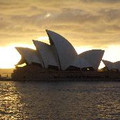的点评
Visiting the nucleus of the nation: 4:20 Extended Tour a must!!
独立厅的点评
点评:Like many buildings approaching their 300th birthday, what we refer to now as Independence Hall has gone through many metamorphoses over the years. It started life as the Pennsylvania State House, with construction beginning in 1732 and lasting over two decades. A wooden tower was completed in 1753, housing the Liberty Bell as the next forty years saw the structure at the epicenter of the American Revolution and its immediate aftermath. As the government moved to Washington, D.C. at the dawn of the 19th century, the building fell into disuse, with the second floor at one point being converted into a natural history museum (!). The approach of the country’s centennial and the aftermath of the Civil War led to the conversion of the area into a national shrine, culminating in the creation of Independence National Historic Park in 1948 and the designation of a UNESCO World Heritage Site in 1979.
I visited the building twice during my week in Philadelphia, the first time independently (pun intended) soon after opening and the second during a formal Extended Tour at 4:20PM. My initial independent visit was brief, merely a self-guided experience of just the first floor. The latter, organized tour lasted forty minutes and was led by a docent (Lynn Nash – very knowledgeable and funny). After meeting outside of the East Wing, we toured both floors of the building, starting in the Supreme Court Room and continuing to the Assembly Room. The general history of each room was described and woven with individual stories of people from the time-period. Continuing up the Tower Stairwell, we saw the second floor consisting of the Long Gallery, Committee of Assembly Chamber, and Governor's Council Chamber. After a brief explanation of the area we were allowed to explore on our own (with recorded harpsichord music in the background) before being ushered downstairs and to the exit. My quick stop at the attached “Essentials” museum (containing original copies of the Declaration of Independence, the Articles of Confederation, and the Constitution) rounded out an unforgettable experience.
In summary, the Extended Tour (certainly more so than my early morning autonomous visit) was an equally essential and interesting visit. It’s tough to imagine an historic site in the country that is more important to our country and the National Parks Service made the correct decision in having this interpreted by the Rangers and not surrendering to a movie or electronic gimmicks to tell the story. Furthermore, the oral presentation by Ms. Nash was very timely and insightful, noting that the freedoms and liberty signed into existence in the Assembly Room were not available to all. The adjacent Essentials Museum was a perfect coda: small, historic, and packed with information. Multiple thumbs up here…. a fantastic visit.
I visited the building twice during my week in Philadelphia, the first time independently (pun intended) soon after opening and the second during a formal Extended Tour at 4:20PM. My initial independent visit was brief, merely a self-guided experience of just the first floor. The latter, organized tour lasted forty minutes and was led by a docent (Lynn Nash – very knowledgeable and funny). After meeting outside of the East Wing, we toured both floors of the building, starting in the Supreme Court Room and continuing to the Assembly Room. The general history of each room was described and woven with individual stories of people from the time-period. Continuing up the Tower Stairwell, we saw the second floor consisting of the Long Gallery, Committee of Assembly Chamber, and Governor's Council Chamber. After a brief explanation of the area we were allowed to explore on our own (with recorded harpsichord music in the background) before being ushered downstairs and to the exit. My quick stop at the attached “Essentials” museum (containing original copies of the Declaration of Independence, the Articles of Confederation, and the Constitution) rounded out an unforgettable experience.
In summary, the Extended Tour (certainly more so than my early morning autonomous visit) was an equally essential and interesting visit. It’s tough to imagine an historic site in the country that is more important to our country and the National Parks Service made the correct decision in having this interpreted by the Rangers and not surrendering to a movie or electronic gimmicks to tell the story. Furthermore, the oral presentation by Ms. Nash was very timely and insightful, noting that the freedoms and liberty signed into existence in the Assembly Room were not available to all. The adjacent Essentials Museum was a perfect coda: small, historic, and packed with information. Multiple thumbs up here…. a fantastic visit.
翻译:像许多即将迎来 300 周年的建筑一样,我们现在所说的独立厅多年来经历了许多变迁。它最初是宾夕法尼亚州议会大厦,始建于 1732 年,历时二十多年。1753 年,一座木塔建成,里面安放了自由钟,在接下来的四十年里,这座建筑成为美国革命及其直接后果的中心。19 世纪初,随着政府迁往华盛顿特区,这座建筑被废弃,二楼一度被改建成自然历史博物馆(!)。随着美国建国一百周年的临近和内战的余波,该地区被改建为国家圣地,最终于 1948 年建立了独立国家历史公园,并于 1979 年被指定为联合国教科文组织世界遗产。
我在费城的一周时间里参观了这座建筑两次,第一次是独立参观(双关语),在建筑开放后不久,第二次是在下午 4:20 的正式延长游览中。我第一次独立参观的时间很短,只是在一楼进行了一次自助游览。后一次有组织的游览持续了 40 分钟,由讲解员(Lynn Nash——知识渊博且风趣)带领。在东翼外会面后,我们参观了建筑的两层,从最高法院会议室开始,一直到会议室。每个房间的一般历史都有描述,并穿插着那个时期人们的个人故事。继续沿着塔楼楼梯向上走,我们看到了二楼,包括长廊、议会委员会会议厅和州长会议厅。在简要介绍完该地区后,我们被允许自行探索(背景中播放着录制的大键琴音乐),然后被带下楼并走到出口。我在附属的“基本”博物馆(包含《独立宣言》、《邦联条例》和《宪法》的原件)短暂停留,结束了一次难忘的体验。
总而言之,这次延长游览(肯定比我清晨的自主游览更重要)是一次同样重要且有趣的游览。很难想象这个国家还有比这更重要的历史遗迹,国家公园管理局做出了正确的决定,让护林员来解释这一点,而不是屈服于电影或电子噱头来讲述这个故事。此外,纳什女士的口头陈述非常及时和有见地,指出在大会堂签署的自由和解放并非人人都能享有。毗邻的 Essentials 博物馆是一个完美的结尾:规模小、历史悠久、信息丰富。这里值得赞许……一次美妙的参观。
我在费城的一周时间里参观了这座建筑两次,第一次是独立参观(双关语),在建筑开放后不久,第二次是在下午 4:20 的正式延长游览中。我第一次独立参观的时间很短,只是在一楼进行了一次自助游览。后一次有组织的游览持续了 40 分钟,由讲解员(Lynn Nash——知识渊博且风趣)带领。在东翼外会面后,我们参观了建筑的两层,从最高法院会议室开始,一直到会议室。每个房间的一般历史都有描述,并穿插着那个时期人们的个人故事。继续沿着塔楼楼梯向上走,我们看到了二楼,包括长廊、议会委员会会议厅和州长会议厅。在简要介绍完该地区后,我们被允许自行探索(背景中播放着录制的大键琴音乐),然后被带下楼并走到出口。我在附属的“基本”博物馆(包含《独立宣言》、《邦联条例》和《宪法》的原件)短暂停留,结束了一次难忘的体验。
总而言之,这次延长游览(肯定比我清晨的自主游览更重要)是一次同样重要且有趣的游览。很难想象这个国家还有比这更重要的历史遗迹,国家公园管理局做出了正确的决定,让护林员来解释这一点,而不是屈服于电影或电子噱头来讲述这个故事。此外,纳什女士的口头陈述非常及时和有见地,指出在大会堂签署的自由和解放并非人人都能享有。毗邻的 Essentials 博物馆是一个完美的结尾:规模小、历史悠久、信息丰富。这里值得赞许……一次美妙的参观。





此点评仅代表旅行者个人的主观意见,并不代表TripAdvisor以及其合作方的意见。
关于我们
|新闻动态
|商务合作
|会员中心
|业主中心
|常见问题
|意见反馈
|联系我们
|营业执照
© 2025 Tripadvisor 版权所有。
使用条款 |隐私政策 |网站工作原理
部分照片由 VFM Leonardo 提供。
* Tripadvisor不是旅行社,也不是旅游预订服务代理商。我们提供免费、客观、公正的旅游资讯服务。 (显示更多)
TripAdvisor LLC 既不是预订代理商,也不是旅游运营商,不会向网站用户收取任何服务费。 按照规定,在 Tripadvisor 发布机票价格、游览和旅行套餐的合作伙伴(航空公司、旅行提供商及预订代理商),其标价须包含所有费用和附加费用。 例如, 机场出入境税费、消费税与其他服务费、手续费、杂费及附加费用。 当您向我们的某个合作伙伴进行预订时,请务必查阅他们的网站以了解当地行政部门要求的所有适用费用的具体情况。 除非另有说明,机票价格通常指的是一个人的价格(以人民币计)。
为方便起见,TripAdvisor LLC 根据从我们的预订合作伙伴获取的空房率计算每个酒店的均价。 对于游览和景点来说,所显示价格通常是每位成人的最低可用价格。 对于列出的任何旅行套餐或优惠,TripAdvisor LLC 无法保证任何特定的费率或价格。 此外,酒店均价每晚会更新,并以您的首选币种表示(使用现行汇率)。 由于这些已换算的价格是预估价格,因此,有关具体金额和币种请与预订网站进行核实。
此外,TripAdvisor LLC 无法保证我们网站上宣传的价格随时有效。 标价可能需要预订一定天数才能生效,或有不可用日期、使用条件或限制。
TripAdvisor公司对外部网站的内容一概不负责。优惠价格中不含税和其他费用。
ICP证:沪B2-20200433
沪ICP备20013175号
 沪公网安备31010502005427号
沪公网安备31010502005427号鹰程信息技术(上海)有限公司
货币/国家及地区
¥CNY
中国

